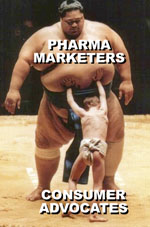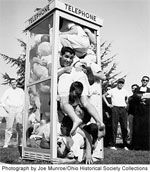Vol. 9, Issue No. 3: MARCH 2010 – EXECUTIVE SUMMARY FDA Can Relax. I Did All the Work for Them! Upfront Commentary
 This issue of Pharma Marketing News does practically all the work for the FDA in summarizing comments submitted to FDA’s docket regarding “Promotion of FDA-Regulated Medical Products Using the Internet and Social Media Tools.”
This issue of Pharma Marketing News does practically all the work for the FDA in summarizing comments submitted to FDA’s docket regarding “Promotion of FDA-Regulated Medical Products Using the Internet and Social Media Tools.”
As I sat down to review the comments, I soon realized there was a lot more work than I bargained for. But I managed to sift through the platitudes to find the real nuggets, especially among the comments submitted by the regulated drug industry itself.
So Jean-Ah and her staff can relax and just copy the articles in this issue when they summarize the comments, which I hope they do when they finally issue the expected guidance.
Read this entire OpEd piece by John Mack here:
www.news.pharma-mkting.com/PMNews_93_UpFront.pdf Industry & Consumer Advocates Square Off on Social Media An Analysis of Who Submitted Comments to FDA This article presents an overview of the types of organizations that submitted comments versus those that made presentations at the November 2009 public hearing. It also includes general comments from the pharma industry regarding the process by which the FDA should regulate the Internet and social media. Also presented in this article are the comments submitted by consumer advocates and individuals who generally supported more strict regulation across the board.
This article presents an overview of the types of organizations that submitted comments versus those that made presentations at the November 2009 public hearing. It also includes general comments from the pharma industry regarding the process by which the FDA should regulate the Internet and social media. Also presented in this article are the comments submitted by consumer advocates and individuals who generally supported more strict regulation across the board.
- Who Submitted Comments?
- Presenters Vs. Commentators
- Pfizer Asks for New FDA Regulations
- First Amendment Concerns
- AstraZeneca Proposes Social Media Principles
- Merck Encourages Ongoing Dialogue
- Most Consumer Advocates Are Anti-Pharma Marketing
Read this article now. It’s FREE…
Overcoming Space Limitations in Social Media Bring Out the Old (“One-Click Rule”) and Ring in the New Ideas
 FDA’s public notice regarding Promotion of Food and Drug Administration-Regulated Medical Products Using the Internet and Social Media Tools asked “Are there proposed solutions that may help address regulatory concerns when using social media tools associated with space limitations or tools that allow for real-time communications to present product information?”
FDA’s public notice regarding Promotion of Food and Drug Administration-Regulated Medical Products Using the Internet and Social Media Tools asked “Are there proposed solutions that may help address regulatory concerns when using social media tools associated with space limitations or tools that allow for real-time communications to present product information?”
FDA’s “regulatory concerns” are primarily about how to ensure that consumers have access to a balanced presentation of both risks and benefits of medical products. Given that, the following question asked by the FDA is relevant to the discussion of space limitation solutions: “How should product information be presented using various social media tools to ensure that the user has access to a balanced presentation of both risks and benefits of medical products?”
This article presents a summary of comments from the drug industry regarding this issue.
Topic headings include:
- Research Supports Need for More Balance
- Pharma Prefers “1-Click Rule”
- Yahoo! Says Patients Are Ambivalent About Risk Information
- Merck’s Data In Support of “One-Click Rule”
- BIO Says Consumers “Understand” the One-Click Rule
- Who Did NOT Support the “One-Click” Rule?
- Google Rescues the Product Claim Ad!
- Novartis Proposes FDA-Approved Hashtags
- PhRMA Proposes FDA-Approved Universal Safety Symbol
- Bayer Opposes Universal Safety Symbol
- TV’s Adequate Provision Precedent
- The Whole and Nothing But the Whole Conversation
- Online Video Ads Special Case
- MicroBlogging about Newsworthy Events
Read this article now. It’s FREE…
Accountability for Pharma Content on Social Media Sites Who Owns and Controls the Content?
 The FDA asked for public comments regarding how pharmaceutical companies should be held accountable for a communication about its product(s) and how much control they exert over activities on the Internet, regardless of whether the promotional activity occurs on company-sponsored venues or on third-party venues. Related to this, FDA also asked whether or not pharmaceutical companies should correct misconceptions or misinformation about their products, including unapproved uses of their products that are being conveyed on a Web site outside their control, such as on a blog, social networking site, or a wiki Web site (i.e., Wikipedia).
The FDA asked for public comments regarding how pharmaceutical companies should be held accountable for a communication about its product(s) and how much control they exert over activities on the Internet, regardless of whether the promotional activity occurs on company-sponsored venues or on third-party venues. Related to this, FDA also asked whether or not pharmaceutical companies should correct misconceptions or misinformation about their products, including unapproved uses of their products that are being conveyed on a Web site outside their control, such as on a blog, social networking site, or a wiki Web site (i.e., Wikipedia).
A substantial portion of the comments submitted to the FDA by the drug industry in response to the FDA was devoted to the accountability issue and the related issue of correcting misinformation on social media sites.
Topic headings include:
- Who Controls the Content?
- Some Communications Are of No Concern to FDA
- Owned, Earned, Shared Media
- Alternative Schemas
- Accountability
- Conversation Is Not Advertising Says Lilly
- Content Syndication
- User-Generated Content
- Patient Advocacy Special Case
- Safe Harbor for Corrections to Misinformation
Read this article now. It’s FREE…
Solving the Social Media Adverse Event Reporting Problem Is It Just Too Much “Noise” to Sift Through?
 Pharmaceutical marketers claim to be prevented from engaging in online conversations with consumers because of FDA’s AE reporting requirements. No drug company wants to be responsible for pro-actively monitoring the entire Internet for potential adverse events. Even so, are adverse events reported on social media sites just a lot of useless “noise” and not worth the effort to sift through?
Pharmaceutical marketers claim to be prevented from engaging in online conversations with consumers because of FDA’s AE reporting requirements. No drug company wants to be responsible for pro-actively monitoring the entire Internet for potential adverse events. Even so, are adverse events reported on social media sites just a lot of useless “noise” and not worth the effort to sift through?
Many presenters at FDA’s November 2009 public hearing on the Promotion of Food and Drug Administration-Regulated Medical Products Using the Internet and Social Media Tools addressed this problem and offered solutions.
Comments submitted to the FDA after the meeting offer more details, which are reviewed in this article.
Topics include:
- AE Monitoring Policies
- Technology Can Help
- Identifying the Reporter
- Solicited vs. Spontaneous AERs
- Terms of Use
- Tools for Monitoring AEs
- What Sites Should be Monitored?
- Are J&J Agents Trolling for Adverse Events on the Internet?
- Patient Privacy Issues Cited
- Reporter “Noise”
- How Frequently Are AEs Mentioned in Social Media?
- Not All AERs Are Equal
- Lilly’s Pilot Study Yields Nada
Read this article now. It’s FREE…



![6 Digital Tools at the Center of Healthcare Digitalization [INFOGRAPHIC]](http://ec2-54-175-84-28.compute-1.amazonaws.com/pharma-mkting.com/wp-content/uploads/2021/04/6DigitalTools_600px-218x150.jpg)




![6 Digital Tools at the Center of Healthcare Digitalization [INFOGRAPHIC]](http://ec2-54-175-84-28.compute-1.amazonaws.com/pharma-mkting.com/wp-content/uploads/2021/04/6DigitalTools_600px-100x70.jpg)




